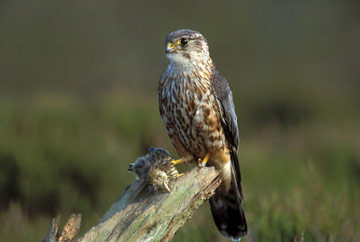
Merlin © John Power
The Merlin is one of a group of predatory birds – with Hen Harrier and Short-eared Owl – that breeds on the fringe of Cheshire and might or might not actually nest in the county. During this Atlas survey, one was seen carrying food to chicks in 2004, the first confirmed breeding within the existing county boundaries for at least seventy years.
It is not at all clear when breeding last took place. Bell (1967) noted a nest in 1951 and 1952 in Longdendale, not now part of Cheshire, and Bell (1962) said that ‘during the last 25 years there is no evidence of it having bred in the hills’, implying that it did so before then, but giving no further substantiation. Coward and Oldham (1910) wrote that ‘possibly an odd pair of Merlins may succeed in rearing their brood on the moors east of Macclesfield, as they undoubtedly do just beyond the Staffordshire border’.
The Merlins of the south Peak District, of which Cheshire forms a small part, have been well studied for the last half-century. A population of 45 pairs in the 1950s suffered a catastrophic decline to near-extinction by 1980, after which the number of occupied nesting areas in the south Pennines increased from 2 (in 1980) to 66 (in 1992) (Newton et al 1981, Brown & Stillman 1998). Their decline had probably been caused – as has been well documented for another bird-eating falcon, the Peregrine – by accumulation of organochlorine pesticides. Merlins feed almost exclusively on small passerines, especially Meadow Pipits which can make up half of their diet. The population recovery followed the gradual cessation of use of these pesticides, aided by a reduction in persecution and egg-collecting.
The records published in Cheshire and Wirral annual bird reports track the recovery. There were odd records in suitable habitat in 1970, 1987, 1989, 1990, 1991, 1993, 1994, 1995, 1996, 1997, 2000 and 2001, and a pair was seen in three years, 1966, 1972 and 2003; breeding is difficult to prove in casual visits, however. Their favoured habitat is moorland with scattered shrubs. The Peak District birds nest mostly on gently sloping ground in heather, less commonly in old Crow nests in trees, avoiding areas of high recreational pressure.
Sponsored by John and Debbie Bannon

